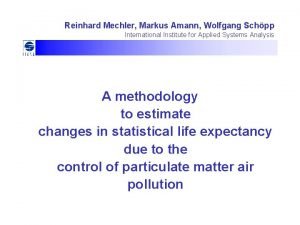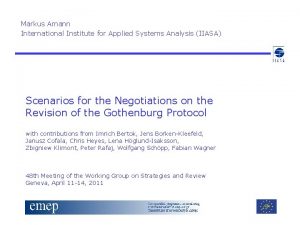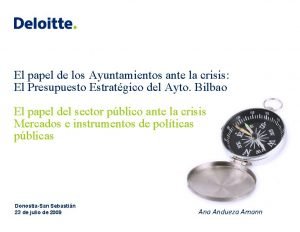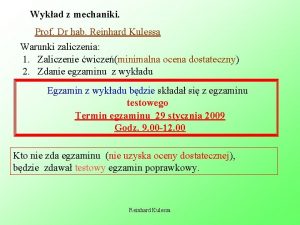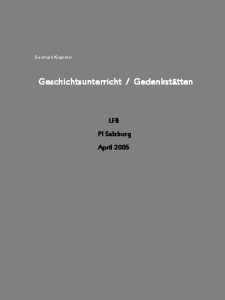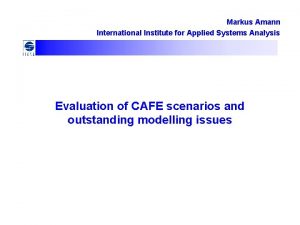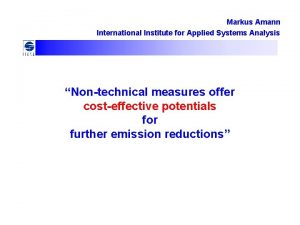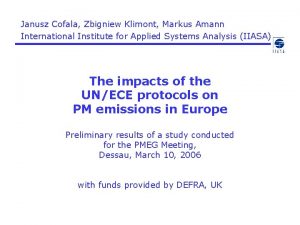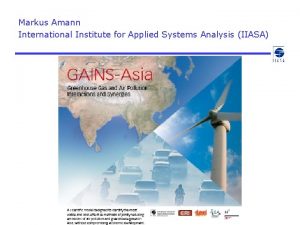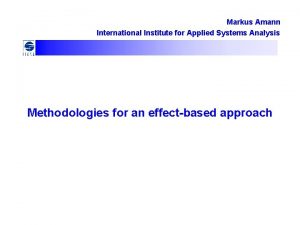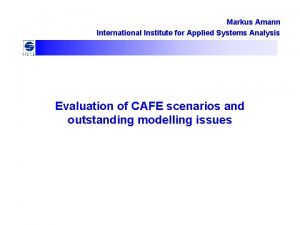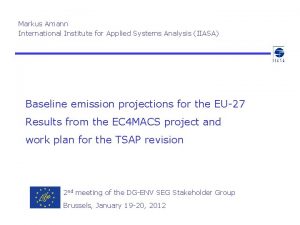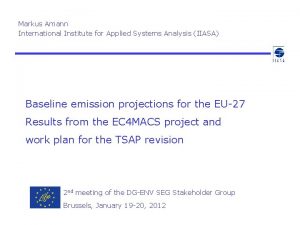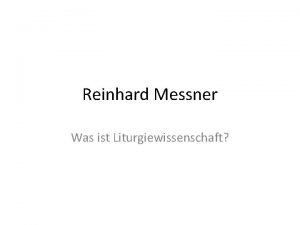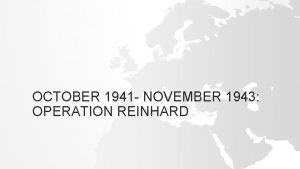Reinhard Mechler Markus Amann Wolfgang Schpp International Institute








![Illustrative results Rural background PM 2. 5 [μg/m 3] 1990 CLE 2010 MFR 2010 Illustrative results Rural background PM 2. 5 [μg/m 3] 1990 CLE 2010 MFR 2010](https://slidetodoc.com/presentation_image_h/aaf5cd3ea976ca9076a7a007c6a02e41/image-9.jpg)
![Illustrative results Losses in avg. life expectancy [months] 1990 CLE 2010 MFR 2010 Illustrative results Losses in avg. life expectancy [months] 1990 CLE 2010 MFR 2010](https://slidetodoc.com/presentation_image_h/aaf5cd3ea976ca9076a7a007c6a02e41/image-10.jpg)
![Illustrative results Losses in avg. life expectancy [days] Illustrative results Losses in avg. life expectancy [days]](https://slidetodoc.com/presentation_image_h/aaf5cd3ea976ca9076a7a007c6a02e41/image-11.jpg)



- Slides: 14

Reinhard Mechler, Markus Amann, Wolfgang Schöpp International Institute for Applied Systems Analysis A methodology to estimate changes in statistical life expectancy due to the control of particulate matter air pollution

Mortality impacts of PM • Time series studies – Relate daily PM with observed daily mortality – Many studies available (APHEA, etc. ) – Chronic effects captured? • Cohort studies – Follow cohorts over decades, relate cohort mortality with PM exposure. Several sites necessary. – Only few studies available, all in US – Capture acute and chronic effects • Measures of mortality: – Cases of premature deaths – Life expectancy - adopted for RAINS

Available cohort studies Seventh-day Adventists study Abbey et al. 1991, 1999 Harvard six cities study Dockery et al. , 1993 Krewski et al. , 2000 American Cancer Society (ACS) study Pope et al. 1995, 2000, 2002 PM 10, 6338 individuals 1977 -1992 RR=1. 12 (1. 01 -1. 24) for 10 μg/m 3 PM 10 RR=1. 13 (1. 04 -1. 24) PM 2. 5, 8000 individuals 1974 -1991 PM 2. 5, 552138 individuals 1979 -2000 HEI-reanalysis: RR=1. 14 RR=1. 07 (1. 04 -1. 11) 2002 reanalysis: RR=1. 06 (1. 02 -1. 11)

Methodology • Life tables provide baseline mortality for each cohort • For a given PM emission scenario: modified mortality through Cox proportional hazard model • From modified mortality, calculate life expectancy for each cohort • With population age statistics: Average life expectancy for entire population • Following report of WHO Working Group on Health Impact Assessment (WHO, 2001)

An example life table

Example implementation • RAINS PM 2. 5 scenarios for 1990, CLE 2010, MFR • RAINS SO 2, NOx, VOC and NH 3 scenarios • Dispersion of primary PM: EMEP PPM model • Formation of secondary PM: EMEP Lagrangian model (to be substituted by Eulerian model) • Urban primary PM: assumed 25% above rural background (awaiting input from CITY-DELTA) • RR of Pope et al. , 2002 • RAINS population data, UN population projections

Population data in RAINS • Urban and rural population for 50*50 km EMEP grid • Compiled from a variety of sources • Geo-statistical data for 2000 • Development up to 2050 based on UN projections • Time-dependent life tables and age structures from UN • Time-dependent countryspecific mortality rates derived

Assumptions • Primary PM in cities 25% above rural background • RR of 1. 06 [1. 02 -1. 11] for 10 μg/m 3 PM 2. 5 (Pope et al. , 2002) • American RR applicable to Europe • No effects below 5 μg/m 3 PM 2. 5 • Linear extrapolation beyond 35 μg/m 3 PM 2. 5 • No effects for younger than 30 years • For each scenario constant exposure 2010 -2080, cohorts followed up to end of their life time • Constant urban/rural population ratios
![Illustrative results Rural background PM 2 5 μgm 3 1990 CLE 2010 MFR 2010 Illustrative results Rural background PM 2. 5 [μg/m 3] 1990 CLE 2010 MFR 2010](https://slidetodoc.com/presentation_image_h/aaf5cd3ea976ca9076a7a007c6a02e41/image-9.jpg)
Illustrative results Rural background PM 2. 5 [μg/m 3] 1990 CLE 2010 MFR 2010
![Illustrative results Losses in avg life expectancy months 1990 CLE 2010 MFR 2010 Illustrative results Losses in avg. life expectancy [months] 1990 CLE 2010 MFR 2010](https://slidetodoc.com/presentation_image_h/aaf5cd3ea976ca9076a7a007c6a02e41/image-10.jpg)
Illustrative results Losses in avg. life expectancy [months] 1990 CLE 2010 MFR 2010
![Illustrative results Losses in avg life expectancy days Illustrative results Losses in avg. life expectancy [days]](https://slidetodoc.com/presentation_image_h/aaf5cd3ea976ca9076a7a007c6a02e41/image-11.jpg)
Illustrative results Losses in avg. life expectancy [days]

Sensitivity analysis • Preliminary analysis limited to uncertainties of RR (95% CI 1. 02 -1. 11) identified by Pope et al. (2002) • Loss in life expectancy (days): Mean 95% CI 1990 496 168 -888 CLE 278 94 -497 MFR 192 65 -344 • Other uncertainties: Extrapolation beyond range of evidentiary studies, transferability, population projections, emission and dispersion calculations, etc. • In principle, error propagation (Suutari et al. ) is possible

Implementation in RAINS • Hard-wired into RAINS • Provides environmental endpoint for PM health effects • Integrated in multi-pollutant/multi-effect framework • How useful is life expectancy for target setting? • Morbidity impacts not addressed because of methodological and data problems • Quantification of ozone morbidity effects? What will drive O 3 reductions?

Conclusions • Methodology for impacts of PM on life expectancy developed • Example implementation in RAINS available • Losses in life expectancy are significant in Europe (~1. 5 [0. 5 -2. 5] years), should improve by 2010, and further improvements still possible • Further uncertainty and sensitivity analysis necessary • Life expectancy as additional endpoint in multi-pollutant/multi-effect strategies • Open how to handle morbidity effects in IA
